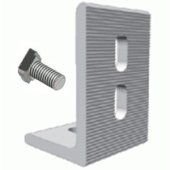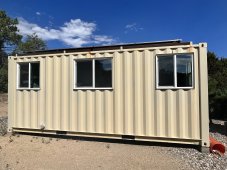I bought some used panels which came with Unirack rails and the L and brackets to mount them pictured below.
My plan is to glue them to the steel top of my shipping containers after removing the paint then coat them and the bare steel with self leveling rv sealant or rubberized roof paint for UV protection.


The L brackets will be oriented as shown in the picture.
The lower foot that will be glued down is 4sq inches. It is anodized and has the same grooved surface shown in the picture.
I contacted JB WELD for suggestions on using one of their products, they suggested silka, 3m , or Dow.
The panels will be flat with the roof in pairs, elevated 4” off the flat roof in portrait orientation. 7 pairs on each 40’ container.
Their mission is to provide shade for the roof as well as electricity.
Anyone have a suggestion for an adhesive that might be up to the task. Something you have worked with?
My plan is to glue them to the steel top of my shipping containers after removing the paint then coat them and the bare steel with self leveling rv sealant or rubberized roof paint for UV protection.


Unirac - L-Foot Serrated, with Integrated Bonding w/ T-Bolt - 304001C
EcoDirect.com sells Unirac at the lowest cost. Order Online or Call Us! 888-899-3509
www.ecodirect.com
The L brackets will be oriented as shown in the picture.
The lower foot that will be glued down is 4sq inches. It is anodized and has the same grooved surface shown in the picture.
I contacted JB WELD for suggestions on using one of their products, they suggested silka, 3m , or Dow.
The panels will be flat with the roof in pairs, elevated 4” off the flat roof in portrait orientation. 7 pairs on each 40’ container.
Their mission is to provide shade for the roof as well as electricity.
Anyone have a suggestion for an adhesive that might be up to the task. Something you have worked with?
Last edited:





